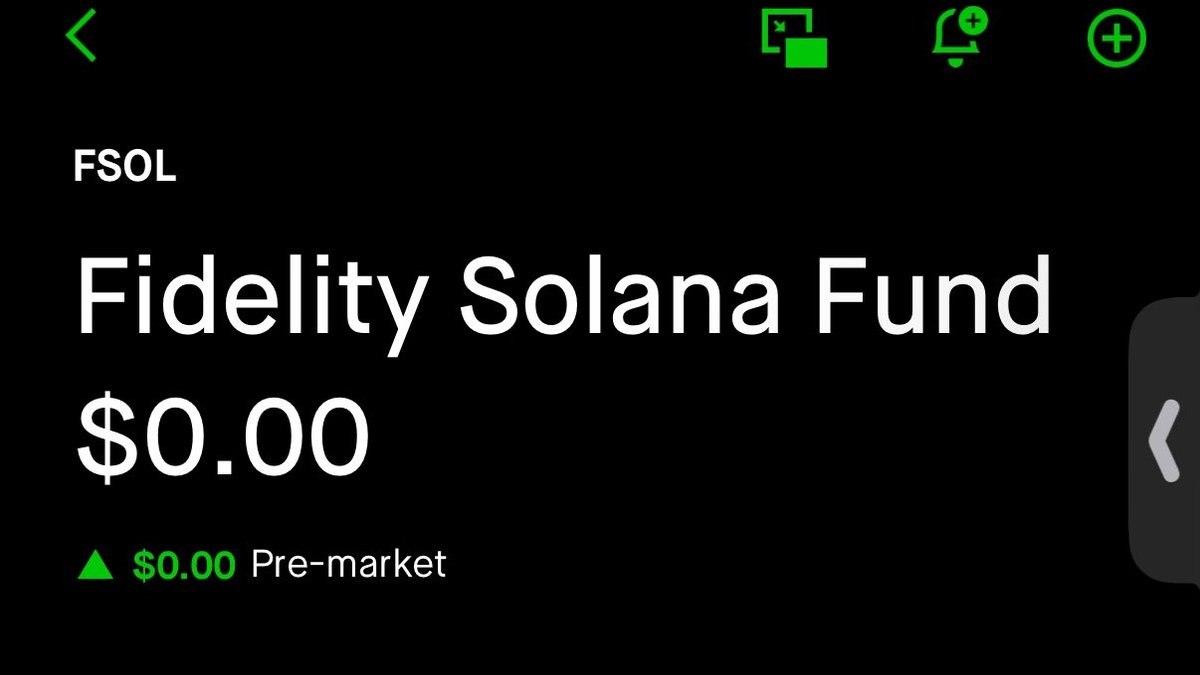Fidelity’s Solana ETF Lands on Wall Street: Another Altcoin Product or a Structural Shift?
The tape from the last 24 hours looks, at first glance, like just another noisy day in crypto: a new ETF launches, regulators publish a dense letter, an old exchange moves coins, and a handful of protocols announce integrations. But step back, and a pattern emerges. The news flow is less about speculative mania and more about market structure – who is allowed to hold what, in which wrapper, and under which rulebook.
At the centre of it all is Fidelity’s Solana ETF, FSOL, now trading on the New York Stock Exchange. With a management fee of 25 basis points (0.25%), FSOL drops one of the largest asset managers on the planet squarely into the Solana race, alongside rivals like 21Shares and Canary Capital.
Meanwhile, the US banking regulator has quietly told banks they may hold crypto on balance sheet to pay blockchain network fees, Mt. Gox has moved more than 10,400 BTC after eight months of silence, and Cypherpunk Technologies has bought enough Zcash to control just over 1.4% of the network’s supply.
This is not a market dying; it is a market being rewired. The question for professionals is not simply whether FSOL pumps SOL in the short term, but what this cluster of moves says about where crypto sits in the global financial stack going into 2026.
1. FSOL: Fidelity turns Solana from “trade” into “product line”
FSOL is not the first Solana ETF, but it might be the most consequential. Fidelity is a household name for pension funds, RIAs and corporate treasurers. When it commits shelf space, it is signalling that a theme has graduated from speculative niche to something that belongs alongside sector equity ETFs and bond funds.
Key characteristics of FSOL, based on current disclosures:
- Listing: NYSE, under the ticker FSOL.
- Exposure: Spot, physically backed Solana – not futures-based or synthetic.
- Fee: 25 bps (0.25%), priced to compete aggressively with other single-asset crypto ETPs.
FSOL launches into an increasingly crowded Solana landscape. 21Shares’ TSOL is set to start trading after Cboe approval, while Canary Capital is pushing its own SOLC vehicle. In just a few months, SOL has moved from being a high-beta altcoin on crypto-native exchanges to the underlying asset in a full-blown ETF segment, complete with fee wars and product differentiation.
The strategic implications go beyond Solana itself:
- ETF-isation of altcoins: Bitcoin and Ethereum were the proof of concept; Solana is the first large non-BTC/ETH chain to get a mainstream, big-brand ETF line-up in the US. That validates the idea that alt L1 exposure is no longer just for offshore derivatives platforms.
- Passive flows for a high-beta chain: As FSOL and its competitors attract assets, they will introduce periodic, rules-based demand for SOL (for creations) and potential supply (for redemptions). That can soften some volatility but also create new feedback loops if sentiment swings.
- Benchmarking risk: Once FSOL exists, CIOs can benchmark “Solana risk” in a regulated wrapper. That makes it easier to underweight or overweight the theme in formal asset-allocation frameworks – and easier to blame or credit Solana exposure at performance review time.
In other words, FSOL is the kind of product that quietly anchors a narrative: Solana isn’t just a trade; it’s a line item.
2. The 24h macro context: crypto slides deeper into the banking rulebook
FSOL doesn’t exist in a vacuum. On the same day Fidelity’s ETF went live, another piece of the puzzle fell into place: the U.S. Office of the Comptroller of the Currency (OCC) clarified that national banks can hold crypto-assets as principal to pay blockchain network fees associated with permissible activities.
At first glance, that’s a narrow use case – banks holding small balances of ETH or other assets to pay gas. But from a market-structure perspective it is significant:
- Legal comfort: The OCC is effectively saying: you may hold crypto on your balance sheet for a clearly defined operational purpose, and here is the interpretive letter that backs you if auditors ask.
- Technical familiarity: The more banks run real transactions on public chains (even just to test systems), the more institutional knowledge accumulates inside the traditional system about key management, fee markets and settlement behaviour.
- Gateway effect: Once banks are set up to hold small amounts of crypto for fees, the marginal operational step to offer custody, settlement or structured products becomes smaller. The internal compliance battle has already been partly fought and won.
Layer that on top of Coinbase CEO Brian Armstrong’s comment that a comprehensive crypto market-structure bill is making “a lot” of progress and could clear Congress in December, and you get a picture of a US system that – slowly, unevenly – is pulling crypto inside its regulatory perimeter instead of trying to exclude it entirely.
Add one more ingredient: President Donald Trump publicly musing that he would love to replace Fed Chair Jerome Powell “right now” and hinting that he already knows who should take the job next. Whatever your politics, that kind of rhetoric injects uncertainty into the interest-rate and inflation outlook that underpins valuations across risk assets, including crypto. Market participants are forced to think not just about whether the Fed will cut or hike, but who will be in the chair making those calls and how much independence the institution will retain.
In short, FSOL arrives at a moment when crypto is no longer external to the financial system. It is being braided into the rulebooks, policy debates and personnel politics that drive the dollar itself.
3. Mt. Gox moves again – and the dog barely barks
For veterans, any headline with “Mt. Gox moves X BTC” still triggers a reflex glance at the price chart. After all, this is the exchange whose collapse defined an era and whose creditor distribution has been a persistent macro overhang for Bitcoin.
Over the last day, the defunct exchange’s wallets shifted roughly 10,423 BTC – about $936 million at current prices – to a new address, and sent another ~185 BTC to Kraken. Historically, moves of this size have triggered immediate selling pressure as traders front-ran potential creditor distributions.
This time, the market reaction has been muted. Bitcoin remains under pressure along with other risk assets, but there has been no obvious panic candle attributable solely to the Mt. Gox transfers. That tells us two things:
- Positioning was ready. After years of headlines about impending repayments, many large investors have already priced in the idea that some creditors will sell. The mystery is not whether Gox coins will move, but on what schedule and through which venues.
- Depth has improved. When Mt. Gox imploded, Bitcoin’s entire market structure was fragile. Today, the spot and derivatives markets are deeper, ETF flows can damp or amplify shocks, and there are more cross-venue arbitrageurs ready to intermediate large moves.
None of that removes the overhang – Gox still holds tens of thousands of BTC – but it does suggest that the market’s ability to digest legacy supply is better than in past cycles. In combination with institutional holdings via ETFs, the flow story is more distributed, less dominated by a single actor.
4. Zcash and the new face of concentrated conviction
At the other end of the spectrum from trillion-dollar Bitcoin is Zcash (ZEC), a long-running privacy-focused chain that has suddenly found itself back in the spotlight. Over the past 24 hours, Cypherpunk Technologies Inc. (CYPH) disclosed that it purchased an additional 29,869.29 ZEC at an average price of $602.63, spending roughly $18 million and lifting its holdings to about 233,644.56 ZEC – roughly 1.43% of total network supply.
For a mid-cap asset, a single entity controlling more than 1% of supply is meaningful. Cypherpunk’s move is a reminder that while Bitcoin and Solana are being sliced into ETFs, other parts of the crypto universe are still shaped by old-fashioned concentrated conviction.
Several points stand out:
- Privacy as a contrarian bet. In a cycle dominated by ETFs and on-chain KYC experiments, doubling down on a privacy coin is a statement about where some investors think value will accrue if regulatory narratives shift or if demand for transaction privacy tightens.
- Liquidity squeeze potential. If Cypherpunk continues to accumulate toward its stated ambition of controlling a larger share of supply, free float in ZEC could become constrained, making the asset more sensitive to relatively small marginal flows.
- Governance and optics. A public company owning a non-trivial slice of a privacy network will attract both curiosity and scrutiny from regulators, activists and other holders. How it votes, stakes (if applicable) or participates in governance could set precedents.
For now, ZEC remains a niche within a niche. But the pattern – listed entities making concentrated, high-conviction bets on specific protocol-level assets – is likely to repeat, especially in segments (privacy, infrastructure middleware, AI-linked tokens) where ETFs are not yet ready or regulators are hesitant.
5. DeFi, stablecoins and infrastructure: the quiet buildout continues
Beneath the headlines about ETFs and regulators, the 24h news cycle also carried a series of smaller but telling updates from the DeFi and stablecoin trenches:
- Tether x Ledn: Tether’s strategic investment in Ledn reinforces the idea that bitcoin-backed credit remains a core primitive. Using BTC as collateral for fiat or stablecoin loans turns a volatile asset into a working balance-sheet tool – crucial if Bitcoin is going to function as a reserve or treasury asset, not just a speculative chip.
- USDG0 and USDai expansions: USDG0’s multi-chain launch (Hyperliquid, Plume, Aptos with LayerZero integration) and USDai’s planned $250 million supply cap increase both push the stablecoin frontier forward. The direction of travel is clear: more chains, more programmatic collateralisation models and more experiments in how “dollars” move within crypto-native environments.
- Sui / Pieverse integration: The integration of protocol x402b into Nexus, extending support for Sui and BNB Chain, is one more illustration of a trend toward cross-chain composability. However the L1 wars shake out at the ETF level, builders are preparing for a multi-chain world.
- HYPE reserve merger delay: The delay in the $1B HYPE reserve merger for lack of enough shareholder votes is a reminder that DeFi is increasingly subject to the same corporate-governance frictions as traditional finance. Token holders are now, in effect, shareholders in complex capital structures.
Put together, these updates suggest that the “plumbing layer” of crypto – lending, stable collateral, cross-chain messaging, DAO governance – continues to evolve even when prices are choppy. That resilience matters for evaluating whether any future selloff is a structural failure or a cyclical washout.
6. Cloudflare, Gemini 3 and the real meaning of outages
One of the more jarring non-crypto headlines in the same 24h window was the Cloudflare outage that disrupted services across the web, including platforms like X (Twitter) and ChatGPT. For digital-asset markets, this is more than an inconvenience; it is a live-fire test of infrastructure assumptions.
Many exchanges, wallets and DeFi front-ends rely on Cloudflare or similar providers for DNS, DDoS protection and routing. When those layers wobble, markets experience fragmented liquidity, delayed feeds and, in some cases, outright inaccessibility – even if the underlying chains are functioning perfectly.
At the same time, Google’s launch of Gemini 3, billed as its most powerful AI model yet, underscores how rapidly computation and automation are advancing on the other side of the stack. The future crypto market will not just be humans clicking web front-ends; it will be machine agents trading, arbitraging and rebalancing 24/7 via APIs.
The combination of a Cloudflare outage and a new flagship AI model in the same news cycle is symbolic. It hints at a future where:
- Markets are increasingly machine-mediated, with bots relying on both centralised Web2 infrastructure and decentralised chains.
- Resilience will require both on-chain robustness and multi-provider redundancy at the network edge.
- Assets like Bitcoin and Solana may become the native collateral and settlement rails not just for human traders, but for autonomous AI systems – a theme that is still underpriced in many fundamental models.
7. Global capital and symbolism: Saudi flows, White House dinners
Finally, a few macro and cultural notes colour the backdrop:
- Saudi Arabia’s $600B US investment plan is a reminder that gigantic sovereign capital flows are in play, reallocating across geographies and asset classes. While this announcement is not crypto-specific, it highlights the scale of capital that might, over time, trickle into digital assets if they are accepted as part of the mainstream investable universe.
- Cristiano Ronaldo and Elon Musk at a White House dinner is symbolism, not policy – but symbolism matters. Crypto and AI are no longer fringe topics; the people most associated with them are fixtures in political and cultural events. That, in turn, shapes how regulators, voters and institutions perceive the legitimacy of the sector.
Overlay that with Trump’s comments about replacing Powell and Armstrong’s optimism about a December crypto bill, and you get a sense of how tightly interwoven the fates of digital assets, macro policy and political theatre have become.
Conclusion: FSOL as a lens on a market growing up
It’s easy to treat Fidelity’s FSOL as just another ticker. In isolation, it’s a small, neat story: a new Solana ETF with a competitive fee, trading on NYSE. But viewed alongside the rest of the last 24 hours – an OCC letter giving banks room to hold crypto, Mt. Gox quietly moving nearly a billion dollars in BTC, a listed company cornering more than 1% of Zcash, and a string of stablecoin and DeFi developments – FSOL looks more like a lens than a headline.
Through that lens, you can see three deeper shifts:
- From retail bets to institutional plumbing. Crypto is being wired into ETF product shelves, banking interpretive letters, pension-fund menus and sovereign investment plans. Price volatility will remain, but the architecture surrounding these assets is starting to look less like a casino and more like an alternative leg of the financial system.
- From simple cycles to complex regimes. The era when traders could build a strategy around a single event – a halving, an airdrop, a regulatory rumour – is fading. Today’s flows respond to interest-rate expectations, cross-asset correlations, ETF creations/redemptions and regulatory sequences like the US shutdown. FSOL’s launch is one variable in a much larger equation.
- From human-only markets to hybrid human–machine systems. As outages like Cloudflare’s remind us of infrastructure fragility, and as AI models like Gemini 3 push the frontier of automation, the market is inexorably moving toward a world where on-chain assets are the native language of both human and algorithmic participants.
Will any of this guarantee higher prices next week or next quarter? Of course not. Mt. Gox overhangs, legislative delays, ETF saturation and macro shocks can all produce harsh drawdowns. But for a professional news and analysis platform, the story to track is not just whether Solana rallies on FSOL’s debut. It is whether the combination of products like FSOL, regulatory shifts like the OCC’s letter and ongoing infrastructure buildout is quietly turning crypto from a series of speculative episodes into a durable piece of the global financial base layer.
On that score, the last 24 hours look less like noise – and more like another brick in the wall.
This article is for informational and educational purposes only and does not constitute investment, trading, legal or tax advice. Digital assets are highly volatile and may be unsuitable for many investors. Always conduct your own research and consider consulting a qualified professional before making financial decisions.







